A Chronology of Haffenreffer Museum Exhibitions
Rip Gerry, Archivist and Exhibit Preparator
Recently Lucy and Carter Buckley, longtime supporters of the Haffenreffer Museum, donated several well-organized binders of archival material (event postcards, newsletters, and newspaper clippings) related to the Museum’s activities and exhibitions. This time capsule inspired me to pull together a history of our exhibitions. The following are highlights from the archival records of more than 200 installations.
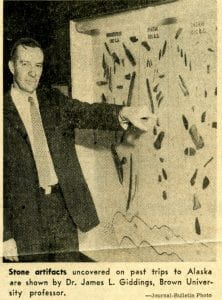
An article mentions that In 1957 (just after the Museum became part of Brown University), the Museum created a “North American gallery” a “small Eskimo room” and a “South American hall” as well as a “Tribal Arts room with artifacts from the rest of the world, including loans from the University of Pennsylvania”. Our first director, J. Louis Giddings recruited students to help with exhibits. He writes, “Pembroke students… being responsible for several new displays” and RISD students being “called in for critical comment and suggestions”. Giddings reports that there are “plans to have the artifacts arranged to tell a story”.
A “Kenyon Household” presented a field collection made by Brown graduate student Joel Titlebaum and a “Guatemalan Marketplace” featuring material collected by Carl Haffenreffer, are mentioned in 1968 press release describing exhibit work by staff under Ruth “Betts” Giddings. Betts took over as Director after her husband death.
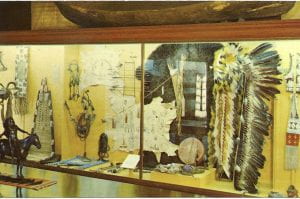
“Special Exhibits” highlighting new collections continued in the 1970s. “Contemporary Eskimo Art” included gifts from artist/author James Houston. “Feather work From the South American Tropical Forest” presented Kenneth Kensinger’s field collection and launched our first publication “The Cashinahua of Eastern Peru”. Sonam Denjongpa a Brown student from Nepal created a “Sikkim Altar” for the gallery while working with Museum education staff. Also working with the museum’s educators but studying at RISD, Enoch Faminu exhibited his paintings depicting life in his Nigerian community. Graduate students continued to create exhibits such as James Dixon’s “A Yukon Excavation” and David Bernstein and Suanne Abel’s “Pre-Columbian Costa Rica” in collaboration with Museum Director Jane Dwyer. In 1979, a “Southeast Asian Handcrafts”exhibition and “refugee Welcoming Festival” takes place.
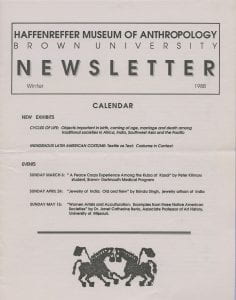
Several installations in the 1980s included exhibit catalogs. Deputy Director Barbara Hail’s 1981 publication, “Hau Kola!” accompanied the exhibition “Traditional Native Americans of the Plains”. In 1983 Thierry Gentis curated “Traditional Art of Africa”, Barbara Hail also curated the 1989 exhibition “Out of the North: The Subarctic Collection”. In 1987 Margot Blum Schevill curated “Costume as Communication: Ethnographic Costumes and Textiles from Middle America and the Central Andes of South America” and authored its accompanying catalog.
During the 1980s, the Museum also presented exhibits on Native American artists including “Women of Sweetgrass, Cedar and Stone”, “Daughters of the Earth” and “Contemporary Paintings (from the Red Cloud Indian School’s collection)”.
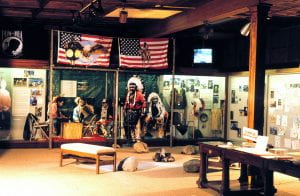
The 1990s included “Entering the Circle: Native People of Southeastern New England” curated by graduate student Ann McMullen. Consultation with a committee of local Native representatives helped shape this response to the Columbus Quincentenary. As part of this exhibition, we produced a documentary video about powwows that featured interviews with The Roaming Buffalo Singers, a local drum group.
“History on Birchbark: The Art of Tomah Joseph, Passamaquoddy” traveled to the Abbe Museum in Maine and was guest-curated by Joan Lester of the Boston Children’s Museum. Close relatives of Tomah Joseph helped develop exhibit themes as part of a Passamaquoddy advisory committee. Director Shepard Krech III, Barbara Hail, Ann McMullen and graduate student David Gregg co-curated “Passionate Hobby: Rudolf F. Haffenreffer and the King Philip Museum”.
The 90s culminated with “Gifts of Pride and Love: Kiowa and Comanche Cradles”, curated by Barbara Hail with support from Kiowa and Comanche cradle-making families, the National Endowment for the Humanities, the National Endowment for the Arts, and the Haffenreffer Family Fund. To accompany the exhibition, we produced a documentary video and interactive DVD. It traveled to six museums including the National Museum of the American Indian.
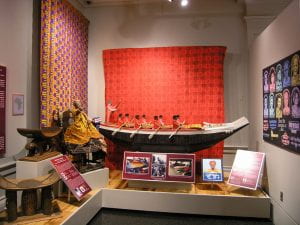
During the first decade of the 2000’s we opened Manning Hall gallery and had our final exhibits in Bristol. Associate Curator Thierry Gentis presented “Dragon Bridge: Taoist Paintings of the Mien”. Graduate student Juliette Rodgers curated “Packrats for Posterity: Relevance in Anthropology Museums”, and graduate student Casey Mesick curated “Facing Mesoamerica”, laying the groundwork for the future exhibit “Reimagining the Americas” at Manning.
“Warp Speeds” was the inaugural show at Manning Hall in 2005. Director Shephard Krech and Deputy Director Kevin Smith curated this textile exhibition drawing on globalization themes developed during Museum Studies seminars. “Believing Africa” followed and also presented themes developed by students.
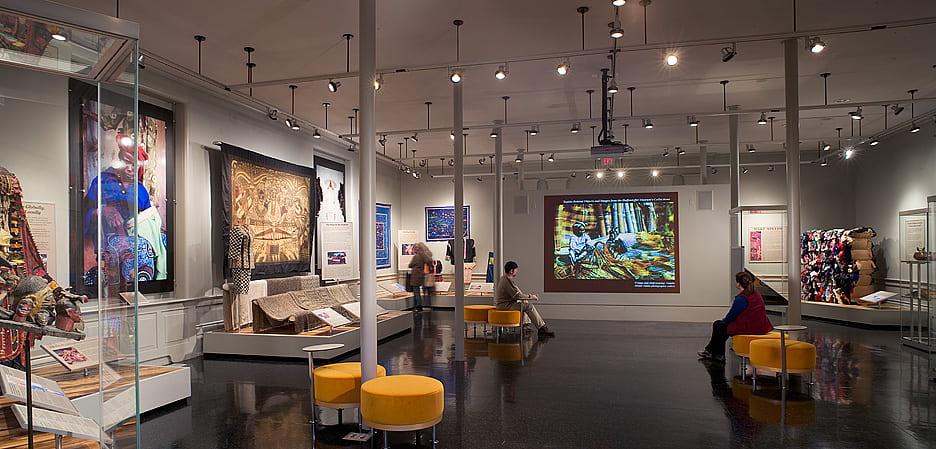
“Day of the Dead: War Dead” honored fallen soldiers in Afghanistan and was the first of several annual Dia de Muertos installations created by Latinx students.
“Reimagining the Americas” opened in 2010 and in 2013 “Crafting Origins: Creativity and Continuity in Indigenous Taiwan” opened with graduate student Christy Delair as head curator. Director Bill Simmons’ contributed to Brown’s 250th celebration in 2014 with “In Deo Speramus: The Symbols and Ceremonies of Brown University”. Kevin Smith curated “Northern Horizons, Global Visions: J. Louis Giddings and the Invention of the HMA”, a celebration of the museum’s first 60 years. In 2018 we focused on several contemporary issues in Native America. “Drone Warriors: The Art of Resistance at Standing Rock”, co-curated by Adrienne Keene (Cherokee) with graduate student Gregory Hitch featured the work of Native activists, as did “Sacred Is Sacred: The Art of Protecting Bear’s Ears”, curated by graduate student Isabella Robbins (Diné).
In June 2022, we closed our most recent exhibition “Transient Matter: Assemblages of Migration in the Mediterranean” It asked us to reflect on border crossings. It was co-curated by Professor Yannis Hamilakis, and his students L. Darcy Hackley, Sherena Razek and Ayşe Şanlı. See the Online Exhibit here.
We are currently working with RISD Professor Bolaji Campbell on our next exhibition at Manning Hall with students in his class “Curating the Modern”. Selections from the Haffenreffer Museum’s collection of contemporary African paintings will be shown for the first time in this exhibit.

Photos from the HMA Archives | Cover photography by Juan Arce